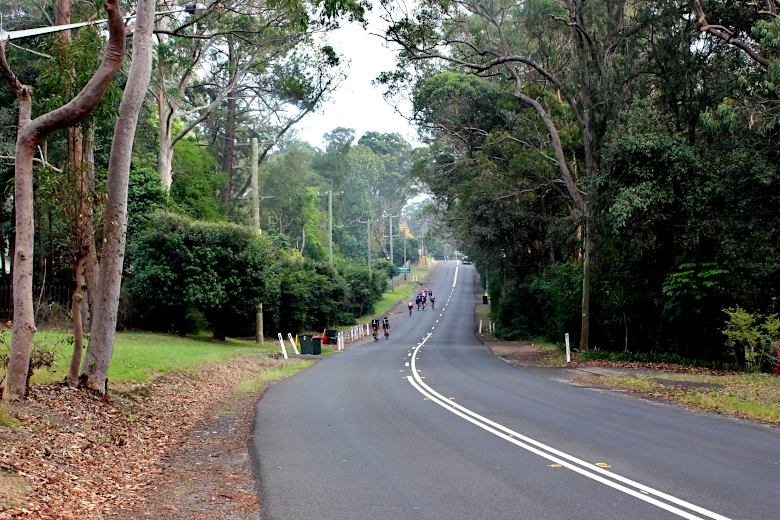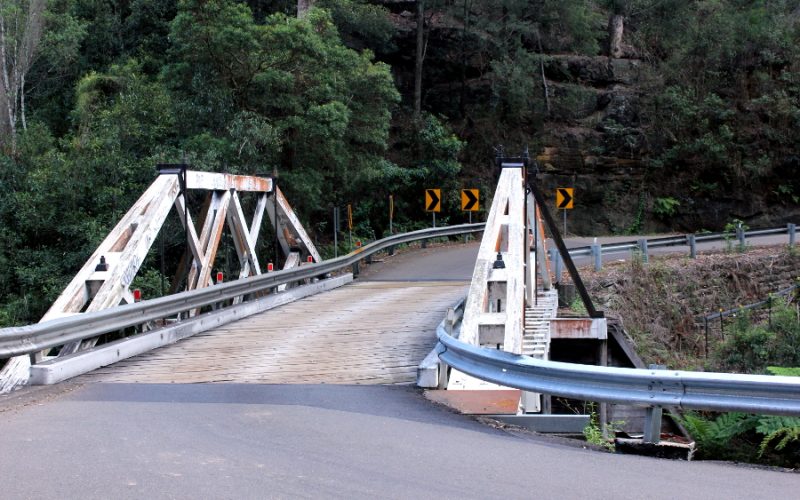For cyclists in Sydney’s north seeking a challenge, the ascent of Galston Gorge West should be near the top of the list. The average gradient of 6% already makes it the steepest of all Three Gorges climbs, but it’s the inconsistency that stings the legs. With pitches swinging between four and eight percent, many riders will be forced out of the saddle just to reach the top.
The Climb
Length: 3.05km
Average gradient: 6%
Elevation gain: 180m
Strava: Galston West
The start
The climb of Galston Gorge West begins just after the old Pearces Creek Bridge (pictured above). The bridge itself is a bumpy ride; pick your path carefully between the steel bolts that dot its wooden surface. The Strava segment commences where the double-lines start in the centre of the road.

After climbing at 5% for the first 200 metres, the first turn is a right hander; a smooth, wide hairpin. There are very few corners for the remainder of the ascent. During the bottom half of the climb, the road rises like a ribbon in front of you, curving gently from side to side, never turning sharply.
The scenery is quite pleasant. With an overgrown rock wall on your left hand side, and tall trees rising from the gorge’s floor to your right, take a moment to breathe in the cool, damp air and enjoy your verdant surrounds.
Inconsistent gradient
The most noticeable difficulty about climbing Galston Gorge West is its inconsistent gradient. The pitch of the road varies every few hundred metres from false flat, to 4%, up to 8%, making it impossible to settle into a comfortable rhythm. At times, you’ll be able to sit in the saddle and spin, but then you’ll be forced to stand up and power through a steep section. That inconsistency, and the overall higher gradient, makes this a more challenging climb than Galston Gorge East.
To the top: ‘draining’ your energy

After climbing in-and-out of the saddle like this for 1.8km, you’ll make a smooth right turn past the Galston town sign. Two hundred metres later, the road switches left and right through a chicane.
After that, a stormwater drain appears on your left, running parallel to the road. This is the sign that you’re in the final third of the climb. Follow the drain as the road curves left. Suddenly, the bushland opens up to residential driveways and grassy nature strips, and you’ll spot the roundabout up ahead.

Pushing hard all the way, go straight through the roundabout, keeping a lookout for the (albeit rare) oncoming car. After the roundabout, you’ll enjoy a short section of false flat. Riders often stop and wait in the road shoulder here, under the trees, but this is not the end of the Strava segment, nor is it the end of the climbing.
Finish

You’ll see the actual top of the climb up ahead, at the T-intersection with Crosslands Road. Cruelly, the finish looks deceptively close, but those final hundred metres take much longer than appearances suggest. The final uphill drag kicks up to over 8%; a final sting in the tail.
Strava shows that the finish line is about 30 metres short of the T-intersection. However, due to GPS drift, it’s best push all the way to the intersection if you’re hunting a personal best.
Strava
The current KOM record is under seven minutes. For a challenging target, B-Grade racers can aim for a sub-10 minute time.
Descent
The descent of Galston Gorge West is mostly straight and fast.
Be careful at the roundabout: it’s unlikely that you’ll have to give way to a car, but keep your fingers within reach of the brakes.
Once you’re among the trees, the fluctuating gradient means you’ll alternate between freewheeling down the steep sections, and pedalling to maintain speed along the false flats. There are only a few corners to worry about; just pay attention to the yellow road signs with the big black arrows.
Slow down near the bottom, as you approach the bridge. Heed the red warning signs beside the road and give way to oncoming traffic, as the bridge is only wide enough for one car.
Traffic

Motor vehicle traffic is low early in the mornings, but since Galston Gorge is the only direct route between Hornsby and Dural, expect a moderate amount of car traffic during the day. Going uphill, drivers generally have good sightlines to overtake safely. Going downhill, cyclists can go as quick, if not quicker, than most drivers. It’s a fairly safe climb, but prepare yourself for that one impatient motorist who squeezes past in anger.
Nearby
At the top of the climb, turn left to stay on Galston Road towards Galston. About a minute down the road, you can stop for coffee and a rest among the local shops and cafes of Galston’s town centre.
Turn right at the town centre towards Fagan Park, a popular picnic spot for families. For a classic Three Gorges route, keep riding past Fagan Park along the dead roads of Arcadia in order to connect to the descent of Berowra Waters West.
Alternatively, for a big day out, some may prefer to continue straight past Galston towards Cattai, Sackville and Wisemans Ferry, exploring the quiet rural-like roads of Sydney’s north-western outskirts.

